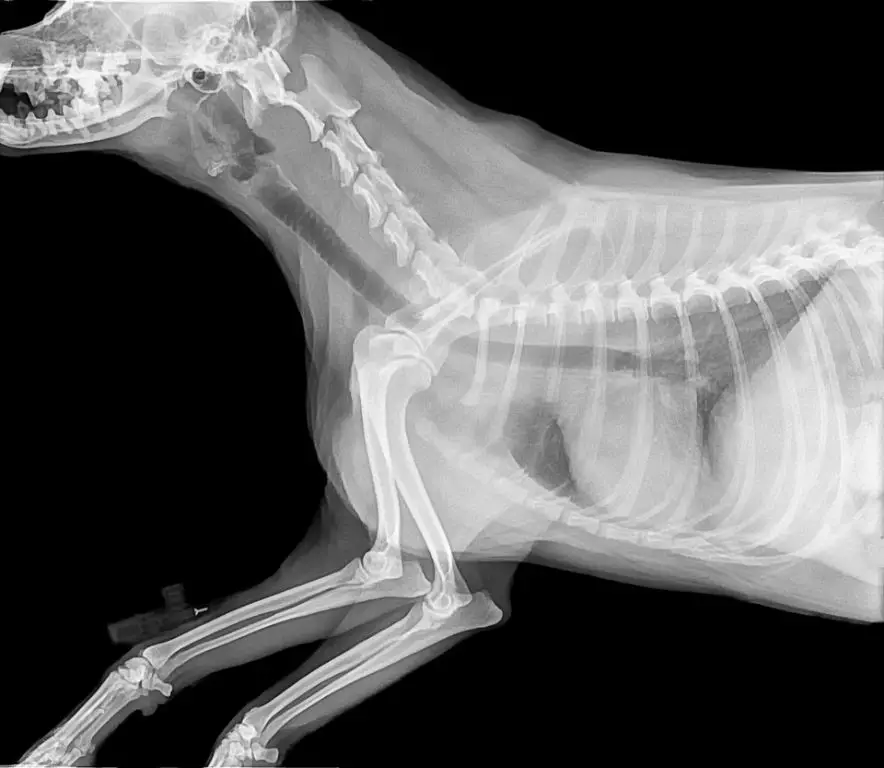Introducing Dog Blockages
A blockage refers to an obstruction or clog in a dog’s digestive tract that prevents normal digestion and the passage of food and waste. Blockages are most common in the esophagus, stomach, and intestines. Common symptoms of a blockage include vomiting, diarrhea, constipation, loss of appetite, bloating, abdominal pain, and lethargy. There are a variety of potential causes of blockages including:
- Foreign objects – Items swallowed by the dog such as toys, rocks, socks, etc.
- Bone fragments – Splintered bones from chew toys or bones
- Hairballs – Excessive licking and swallowed hair
- Tumors or masses – Growths that obstruct the GI tract
- Hernias – Part of the intestine protrudes and twists
- Intussusception – Part of the intestine collapses into itself
- Volvulus – Twisting of the stomach or intestines

Impact on Defecation
A blockage in a dog’s digestive system can significantly impact their ability to defecate normally. This is because blockages interfere with the normal movement of food and waste through the intestines. Depending on the location and severity of the blockage, it may partially or completely obstruct the passage of stool.
Partial blockages allow some food and feces to slowly squeeze past the obstruction. This can lead to narrow, ribbon-like stools. A dog may strain excessively to pass small amounts of abnormal stool. They may defecate small amounts frequently rather than complete bowel movements at normal intervals.
With complete obstructions, no food or waste can get by. This results in an inability to defecate anything at all until the blockage is resolved. The dog’s abdomen may become painful and distended from built up waste and gas. They may strain unsuccessfully to defecate. This lack of bowel movements combined with vomiting are clear signs of a complete intestinal blockage requiring emergency veterinary care.
So in summary, intestinal blockages in dogs can significantly alter defecation leading to narrow stools, straining, and even a complete inability to poop. These changes in bowel movements can indicate the severity of the blockage and need for veterinary treatment.
Types of Blockages
There are several common types of blockages that can occur in a dog’s digestive tract:

Foreign Objects – Dogs are prone to eating things they shouldn’t, which can cause obstructions if they become lodged in the esophagus, stomach or intestines. Common foreign objects include rocks, socks, corn cobs, toys, balls, sticks, bones, string, cloth items and plastic objects.
Tumors – Growths and masses, whether benign or malignant, can obstruct passageways in the digestive tract. Tumors in the mouth, esophagus, stomach, small intestines or colon may partially or fully block the opening.
Intussusception – This is when one part of the intestine telescopes into another segment causing a blockage. It often occurs at the junction between the small and large intestines. Intussusception is more common in puppies than adult dogs.
Other less common causes of obstructions include hernias, scar tissue, inflammatory bowel disease and intolerance to certain foods.
Diagnosing a Blockage
If a blockage is suspected, the vet will perform a thorough physical exam of the dog. They will palpate the abdomen to feel for any obstructions or enlarged organs. The vet will also listen to the dog’s bowel sounds with a stethoscope. With an obstruction, the bowel sounds are typically decreased or absent.
Diagnostic imaging tests are often needed to confirm and locate a blockage. These may include:
- X-rays – Can identify many obstructions and reveal the location.
- Ultrasound – Provides detailed imaging of the gastrointestinal tract.
- Contrast studies – Barium is given by mouth and followed through the system via x-rays.
Bloodwork may also be done to check for signs of infection, electrolyte imbalances, and kidney issues that could result from an obstruction. The bloodwork can also provide clues about potential underlying diseases.
In many cases, imaging combined with a physical exam is sufficient for a vet to make a definitive diagnosis of a blockage. Identifying the location and cause of the obstruction will allow the vet to determine the best treatment options.
Treating Blockages
Treatment for a dog blockage will depend on the location, cause, and severity of the obstruction. However, most options aim to clear the blockage and prevent lasting damage.

Common treatment methods include:
- IV fluids – Dogs with a blockage may be dehydrated and need intravenous fluids to restore fluid levels and electrolyte balance.
- Surgery – If the blockage cannot pass on its own or with medication, surgery may be performed to manually remove the obstruction.
- Medications – Laxatives, stool softeners, or other medications may help loosen the blockage so it can pass through the intestines.
- Enemas – In some cases, an enema can help dislodge and flush out a lower intestinal blockage.
- Dietary changes – Prescription low residue or high fiber diets may aid in moving along an obstruction.
In mild cases of partial obstruction, vets may recommend watchful waiting along with medication and IV fluids to see if the blockage resolves on its own. However, complete obstructions usually require immediate surgery.
Quick action is key to prevent lasting gastrointestinal damage or even death. Close monitoring and follow-up care are also crucial after initial treatment.
Preventing Blockages
There are several steps pet owners can take to help prevent their dogs from developing blockages. Diet and exercise are both key factors, as is close supervision of your dog’s activities. Some tips for avoiding blockages include:
- Feeding your dog high-quality food designed for their age, size, and activity level. Avoid overfeeding.
- Adding water to kibble to help it pass more easily through the digestive tract.
- Avoiding potentially high-risk foods like bones, corn cobs, sticks, rocks, and socks.
- Exercising your dog regularly to encourage healthy digestion and bowel movements.
- Supervising playtime with toys and other objects that could potentially cause an obstruction if swallowed.
- Keeping harmful items out of reach, such as string, rubber bands, children’s toys, and cooked bones.
- Maintaining a predictable and stress-free environment to avoid anxious behaviors like overeating or eating objects.
While intestinal obstructions can happen fairly commonly in dogs, pet owners can take proactive steps to lower the risks. Paying close attention to your dog’s diet, exercise, and environment can go a long way in preventing potential foreign object blockages.
Outlook and Prognosis
If a dog has a blockage but receives prompt veterinary treatment, the prognosis is often good. With medications, intravenous fluids, and supportive care, many dogs recover fully from blockages within a few days. However, the prognosis depends on the location and severity of the blockage.
Blockages in the stomach or upper small intestines usually have better outcomes than blockages further down in the intestinal tract. Partial blockages also tend to have better prognoses than complete blockages which cause a full obstruction. With complete blockages, dogs can develop potentially life-threatening conditions like gastric dilation volvulus (GDV) or septic peritonitis if the blockage is not treated quickly.
Without veterinary treatment, the prognosis for a dog with a blockage is poor. As the blockage worsens, dogs experience progressively worsening clinical signs like vomiting, diarrhea, loss of appetite, lethargy, and abdominal pain. Eventually, dogs with untreated blockages can go into hypovolemic shock, experience intestinal tissue death, and even die if the blockage is not resolved.
So early diagnosis and prompt treatment are key when it comes to optimizing the prognosis for a dog with any type of gastrointestinal blockage. Consulting a veterinarian right away when signs of a possible blockage first arise gives a dog the best chance at making a full recovery.
When to See a Vet
If your dog is showing any of the following signs, you should take them to the vet immediately:
-
Repeated vomiting
-
Inability to defecate or pass gas
-
Distended or painful abdomen
-
Lethargy
-
Loss of appetite
-
Fever
-
Straining to defecate without producing anything
-
Coughing
-
Gagging
-
Difficulty breathing
-
Collapsing
-
Whining or crying in pain
These are signs of a serious blockage or obstruction that requires emergency surgery. Don’t wait to see if the symptoms resolve on their own – get veterinary help immediately. Time is critical, as a complete blockage can be fatal if not treated promptly. Don’t hesitate to seek emergency vet care if your dog exhibits these concerning symptoms.
Caring For a Dog With a Blockage
If your dog has a mild blockage and does not require intensive veterinary care, there are steps you can take at home to help your dog feel more comfortable until the blockage passes:

- Withhold all food for 12-24 hours to give your dog’s digestive system a rest. Only allow small sips of water.
- Avoid exercising or overly exciting your dog, as this can worsen the blockage.
- Confine your dog to a comfortable, quiet area with easy access to fresh water.
- Check on your dog frequently and watch for signs of worsening condition.
- Gently massage your dog’s abdomen to help stimulate the digestive tract.
- Consider giving stool softeners if recommended by your vet.
- Monitor bowel movements and note if your dog is straining or unable to pass stool.
- Clean up any vomit immediately to prevent re-ingestion.
- Contact your vet if symptoms persist or get worse.
While at-home care can provide some relief, it’s critical to follow up with your vet if your dog’s blockage does not resolve within 12-24 hours. Leaving a blockage untreated can lead to serious, even fatal consequences. Your vet may recommend IV fluids, medication, endoscopic removal of the blockage, or surgery for persistent or severe cases.
Frequently Asked Questions
Dog owners often have many questions when it comes to gastrointestinal blockages. Here are some of the most frequently asked questions:
Will my dog still poop if they have a blockage?
In most cases, a dog with a complete intestinal blockage will stop being able to defecate. They may strain to poop but nothing comes out or only a small amount of liquid feces may be passed. Lack of bowel movements is one of the first signs of a blockage.
What are some signs my dog has a blockage?
Signs of a possible blockage include vomiting, diarrhea, loss of appetite, abdominal pain, straining to defecate with no stool, dehydration, and lethargy. If you see any of these, take your dog to the vet right away.
How do dogs get blockages?
Dogs can get blockages from eating inedible objects, bones, sticks, rocks, socks, packaging materials, toys, etc. Fatty foods can also lead to pancreatitis and blockages. Some dogs are more prone to blockages if they eat too fast.
How is a blockage diagnosed?
Vets use imaging tests like abdominal x-rays or an ultrasound to visualize foreign objects lodged in the gastrointestinal tract. Bloodwork may show elevated white blood cell count. Exploratory surgery is sometimes needed both to diagnose and remove an obstruction.
Can I treat my dog’s blockage at home?
No, blockages should always be treated by a vet. At home care like withholding food and water can be dangerous. Trying to induce vomiting is also not recommended. Surgery is often needed to remove the obstruction.
How can I prevent future blockages?
Pick up all items your dog could chew or swallow like toys, rocks or sticks from the yard. Keep trash and food packaging away from pets. Use toys too big to be swallowed and monitor their condition. Feed dogs slowly and use a bowl that prevents fast eating.